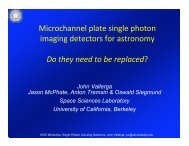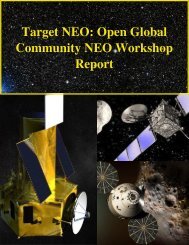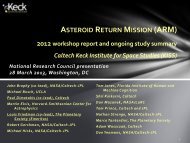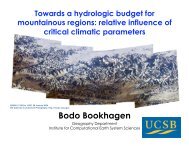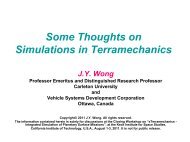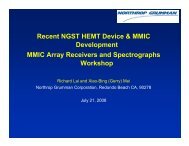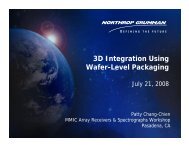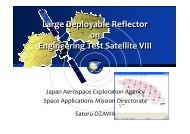Single Photon Counting Detectors
Single Photon Counting Detectors
Single Photon Counting Detectors
- No tags were found...
You also want an ePaper? Increase the reach of your titles
YUMPU automatically turns print PDFs into web optimized ePapers that Google loves.
Jet Propulsion LaboratoryCalifornia Institute of Technology<strong>Photon</strong> <strong>Counting</strong> <strong>Detectors</strong> forLaser Communications andInterplanetary Light ScienceWilliam H. FarrJet Propulsion Laboratory • California Institute of TechnologyKISS SPCD WorkshopJanuary 25-29, 2010Pasadena, CA, USAJet Propulsion Laboratory • Optical Communications Groupfor planning and discussion purposes onlyCopyright 2010 California Institute of Technology. Government Sponsorship Acknowledged.WHF 1
Jet Propulsion LaboratoryCalifornia Institute of TechnologyI. Laser CommunicationsII. SPCDs for Laser CommIII. SPCD Characterization for Laser CommIV.Interplanetary Light ScienceV. Path ForwardKISS SPCD WorkshopJanuary 25-29, 2010Pasadena, CA, USAJet Propulsion Laboratory • Optical Communications Groupfor planning and discussion purposes onlyWHF 2
Deep Space Communications CapabilityJet Propulsion LaboratoryCalifornia Institute of TechnologyKISS SPCD WorkshopJanuary 25-29, 2010Pasadena, CA, USAJet Propulsion Laboratory • Optical Communications Groupfor planning and discussion purposes onlyWHF 3
Interplanetary Laser CommunicationsJet Propulsion LaboratoryCalifornia Institute of Technology• Optical communicationsmust provide cost effectivehigher data rate per kilogramand per Watt than RFsystems to be acceptedfor operations• Reduction of spacecraftburden is the overridingconcern– Mass, power, delta-V limits• Result is a photon starvedcommunications channelGEO: .00024 A.U.Moon: .0028 A.U.dB Improvement Required(relative to 10 Gbps at GEO)706560555045403510 Mbps linkMars Jupiter Saturn Uranus Neptune1 2 5 10 20Range (A.U.)• Deep space optical communications technology targets gains through:– Pointing: High carrier frequency allows narrow beams from small transmit apertures– Coding: GigaHertz bandwidth traded for high bits per photon efficiency at lower data rates– Detection: Efficient and high rate photon countingCount every photon andmake every photon count!KISS SPCD WorkshopJanuary 25-29, 2010Pasadena, CA, USAJet Propulsion Laboratory • Optical Communications Groupfor planning and discussion purposes onlyWHF 4
Laser Communications LinkJet Propulsion LaboratoryCalifornia Institute of TechnologyTransmitterTelescopeNear-sun PointingReceiver TelescopeInputDataOptical ChannelDataOutputEncoder /ModulatorLaserTransmitterDetectorArrayDiscriminatorReceiverDecoderEarth’s AtmosphereFPGA BasedModulatorFPGA BasedDemodulator ElectronicsKISS SPCD WorkshopJanuary 25-29, 2010Pasadena, CA, USAJet Propulsion Laboratory • Optical Communications Groupfor planning and discussion purposes onlyWHF 5
Data Modulation for Interplanetary CommJet Propulsion LaboratoryCalifornia Institute of Technology• Present emphasis on Pulse PositionModulation (PPM) and phase insensitivedetection with <strong>Single</strong> <strong>Photon</strong> <strong>Detectors</strong>– GHz bandwidths and up to ~3 bits perdetected photon efficiency at 1 to 1.6 µm– Requires high peak-to-average power lasersDetector Classphase insensitiveamplifierdual quadraturesensitivesingle quadraturesensitiveExamplesparametric amplifier, Ramanamplifier, laser amplifierCapacity Limitbits/photon1.44Coherent heterodyne 1.44Coherent homodyne,degenerate parametric amplifier2.88MT sT wT GAlphabet sizeSlot WidthSymbol TimeGuard TimeM*T sT GT wphoton countingPhotomultiplier tube, Geigermode APD, NbN nanowirehn/2kTln2(~ 69 @ 1 µ m, 150K)• Binary Phase Shift Keying (BPSK)modulation could provide “quantumoptimum”performance– Receivers operating above the atmospherewould be desired for this– BPSK would eliminate the present high peakto-averagepower technology driver– However, no one knows how to build the“optimal receiver” yet, although it will likelyrequire phase sensitive single photondetectorsKISS SPCD WorkshopJanuary 25-29, 2010Pasadena, CA, USAJet Propulsion Laboratory • Optical Communications Groupfor planning and discussion purposes onlyUltimate capacity of a pure-loss channel and thecapacities of structured transmitter and receiversWHF 6
Jet Propulsion LaboratoryCalifornia Institute of TechnologyI. Laser CommunicationsII. SPCDs for Laser CommIII. SPCD Characterization for Laser CommIV.Interplanetary Light ScienceV. Path ForwardKISS SPCD WorkshopJanuary 25-29, 2010Pasadena, CA, USAJet Propulsion Laboratory • Optical Communications Groupfor planning and discussion purposes onlyWHF 7
<strong>Single</strong> <strong>Photon</strong> <strong>Counting</strong> <strong>Detectors</strong> (SPCD)Jet Propulsion LaboratoryCalifornia Institute of Technology• <strong>Single</strong> photon counting detectors (SPCD) are the mostsensitive detectors for electromagnetic radiation– But the ideal single photon detectorwith 100 % detection efficiency zerodark count rate and after-pulsing,zero timing jitter, high bandwidthand dynamic range does not existParameter Description UnitsQuantumEfficiencyQEdetectoramplifierdiscriminatorRatio of generated primary photocarrier rate toincident photon rate%(unitless)SpectroscopyFluor., Raman, …TCSPSQuantumQKD, computing, …ImagingScint., low-light, …LidarCommunications<strong>Photon</strong> starvedDetectionEfficiencyDark CountRateAfter-PulsingRatioDEDCRAPRRatio of rate of distinguishable electrical outputpulses to incident photon rateRate of distinguishable electrical output pulses (at agiven DE operating point) with no optical inputRatio of correlated secondary distinguishableelectrical output pulses to primary distinguishableelectrical output pulses (at a given DE point)%(unitless)Hz%(unitless)EasyDifficultDetectionEfficiencyM L H M L HDark Rate L M L L M HDynamicRangeL L L M L H<strong>Single</strong><strong>Photon</strong> JitterRecoveryTimeSaturationRateSPJTiming uncertainty between arrival of incidentphotons to distinguishable electrical output pulsesTime after a photon detection event for the DE torecover to a specified fraction of the limiting (lowrate, maximum) DE valueMean rate of distinguishable electrical output pulsesunder continuous wave (Poission) illumination forwhich apparent SPDE drops to a specified fraction ofits limiting (low rate, maximum) valuessHzBandwidth M H H L H HJitter H L L H L LHigh Bandwidth and low <strong>Single</strong> <strong>Photon</strong> Jitter areessential requirements for high rate photon countingfor efficient laser communicationsKISS SPCD WorkshopJanuary 25-29, 2010Pasadena, CA, USAJet Propulsion Laboratory • Optical Communications Groupfor planning and discussion purposes onlyWHF 8
<strong>Single</strong> <strong>Photon</strong> Detector TechnologiesJet Propulsion LaboratoryCalifornia Institute of TechnologySome Vis/NIR SPD’s Characterized in JPL’sOptical Communications Detector Calibration FacilityDeviceWavelength(nm)DEDark Rate(Hz/mm2)RiseTime(ns)1-sJitter(ps)Dia.(mm)Temperature(K)Saturation(0.5 dB)CommentSi GM-APD 400 .. 1060 20-40% 1.E6 0.2 1200 0.03 270 .. 300 5 MHzlarge jitter contribution fromdecay tailSi:As (VLPC) 400 .. 850 > 50% 1.E5 0.5 600 1 6 .. 9 17 MHz > 90% DE at peakPt:Si:As (NIPC) 400 .. 2000 40% viableKISS SPCD WorkshopJanuary 25-29, 2010Pasadena, CA, USANote: table values are “characteristic” of well performing devicesJet Propulsion Laboratory • Optical Communications Groupfor planning and discussion purposes onlyWHF 9
Intensified Photodiode <strong>Detectors</strong>Jet Propulsion LaboratoryCalifornia Institute of Technology• The Intensified Photodiode (IPD) offers thebest combination of high detection efficiency,high count rate, and large detector area– The IPD uses a two-stage gain process to achievesingle photon sensitivity:• Ultra-low noise multiplicationon the order of 10 3 viaenergetic impact of kinetic (8KV typical) electrons onto aGaAs semiconductor anode• Avalanche multiplication withgains on the order of 10 withina high-field region of thesemiconductor anode(avalanche diode)– Both single pixel and multi-pixel (array)configurations are available• Using the IPD, JPL has demonstratedemulated Mars links at 47 Megabits/s andefficiencies over 2.8 bits per detected photon280.01.70 V2.00 V2.10 V2.20 V270.0260.0 250.0 240.0Temperature (K)230.0220.0InGaAs IPD Detection Efficiency at 1064 nmInGaAs IPD 500 ps FWHM<strong>Single</strong> <strong>Photon</strong> ResponseDE %43.041.039.037.035.033.031.029.027.025.0KISS SPCD WorkshopJanuary 25-29, 2010Pasadena, CA, USAJet Propulsion Laboratory • Optical Communications Groupfor planning and discussion purposes onlyWHF 10
NbN Superconducting Nanowire DetectorJet Propulsion LaboratoryCalifornia Institute of Technology• Nb(Ti)N Superconducting Nanowire <strong>Single</strong><strong>Photon</strong> <strong>Detectors</strong> (SNSPD) can have highdetection efficiency coupled with low dark rate– Detection efficiencies > 80% observed at ~2K– Best devices fabricated at JPL to date have
Negative Avalanche Feedback <strong>Detectors</strong>Jet Propulsion LaboratoryCalifornia Institute of Technology• <strong>Single</strong> photon detectors incorporating NegativeAvalanche Feedback (NAF) operating at 1550 nmare simple two terminal devices requiring onlyDC bias and a low cost RF amplifier for singlephoton sensitivity– High sensitivity and low noise can be achieved withsimple thermoelectric cooling.– Free-running and self-resetting, NAF APDs can saturateat rates 100 X higher than Geiger mode APDs• JPL has collaborated with three partners (todate) to develop these novel InGaAs APDsTCB NFAD DAPD NoteSPDE 14% 22% 8.5%measured at 1534nmDCR 6 MHz 0.1 MHz 3 MHz at highest SPDEAPRnotmeasuredSPDJ 850 ps 240 ps 13.5 ns30% 50% at highest SPDE1-σ at highestSPDErecovery 60 ns 20 ns 1 ns at highest SPDEsaturation 3 MHz 8 MHz 5 MHz1 dB loss;function ofdetector areaUCSD Transient Carrier Buffer<strong>Single</strong> <strong>Photon</strong> DetectorPLI Negative FeedbackAPD 16 Element ArrayATI Discrete AmplificationPhoto-Detector2004Validated ATI Si NAF2005UCSD InGaAs on Si NAF2007UCSD TCB InGaAs NAF2008PLI & ATI InGaAs/ NAFKISS SPCD WorkshopJanuary 25-29, 2010Pasadena, CA, USAJet Propulsion Laboratory • Optical Communications Groupfor planning and discussion purposes onlyWHF 12
InGaAs/InP Negative Avalanche Feedback APD• In 2007, JPL and UCSD demonstrated the first ever near-infraredphoton counting with an InGaAs Negative Avalanche Feedback(NAF) detector– Non-Geiger mode 1.5 µm photon counting at 295K– NAF eliminates the need for complicated Geiger mode readout circuitryas the device avalanche is gain limited and self resetting• Gain bandwidth product is greater than 10 THz– Negative feedback was achieved through a “Transient Carrier Buffer”designJet Propulsion LaboratoryCalifornia Institute of TechnologyFocused 1.5 mm spoton 10 µ m Device6Device 2C14 at 293.8 K5432Gain, M (x10^5)Excess Noise Factor, F1(a) Schematic diagram of InGaAs–InAlAs SPCD layer structure.(b) Concept of operation for the InGaAs–InAlAs SPCD showingthe self-quenching and self-recovery processes.034.5 35.0 35.5 36.0 36.5 37.0Bias VoltageTCB Gain and Excess Noise Dependence on Bias VoltageKISS SPCD WorkshopJanuary 25-29, 2010Pasadena, CA, USAJet Propulsion Laboratory • Optical Communications Groupfor planning and discussion purposes onlyWHF 13
Jet Propulsion LaboratoryCalifornia Institute of TechnologyI. Laser CommunicationsII. SPCDs for Laser CommIII. SPCD Characterization for Laser CommIV.Interplanetary Light ScienceV. Path ForwardKISS SPCD WorkshopJanuary 25-29, 2010Pasadena, CA, USAJet Propulsion Laboratory • Optical Communications Groupfor planning and discussion purposes onlyWHF 14
SPD Output PulsesJet Propulsion LaboratoryCalifornia Institute of Technology• Geiger mode SPD’s can beconsidered to incorporate a“virtual discriminator” afterthe internal gain mechanism;external reset is required,followed by a recovery(“dead”) timedetectoramplifierdiscriminator• A Superconducting NanowireSPD (SNSPD) has a fastleading edge, but kineticinductance (proportional tonanowire length) limitsrecovery timeoptical pulse envelope• Linear mode photon counters(Photo-Multiplier Tube (PMT),Intensified PhotoDiode (IPD)and Negative AvalancheFeedback (NAF) SPDsgenerate short pulses;recovery time is essentiallythe device pulse width.KISS SPCD WorkshopJanuary 25-29, 2010Pasadena, CA, USAJet Propulsion Laboratory • Optical Communications Groupfor planning and discussion purposes onlyWHF 15
DE, DCR, and SaturationJet Propulsion LaboratoryCalifornia Institute of Technology• DE and saturation rates for optical communications applications are bestcharacterized using continuous illumination– Thermal emitter (noise) or greatly attenuated laser (signal) well approximate a Poisson source350– Finite pulse widths and SPCD recovery times lead to undercounting at high flux rates• Recovery time greater than SPCD output pulse width is sometimes referred to as “dead” time– Undercounting losses can be recovered by splitting the input optical signal across multiple detectors300counted rated (MHz)250200150100Detection Efficiency500Dark Count RatePMS400JPL countercounter limitJPL 10 GHz photon countingreceiver board outperforms bestavailable commercial boards0 100 200 300 400 500Poisson rate (MHz)KISS SPCD WorkshopJanuary 25-29, 2010Pasadena, CA, USAJet Propulsion Laboratory • Optical Communications Groupfor planning and discussion purposes onlyWHF 16
<strong>Single</strong> Timing <strong>Photon</strong> JitterJet Propulsion LaboratoryCalifornia Institute of Technology• Timing jitter limits ultimate SPD bandwidth– Effects of finite pulse width and recovery timemay be mitigated by use of edge detection andarrays, but not timing jitter• <strong>Single</strong> photon jitter can be directlycharacterized using a mode-locked lasersource attenuated to a Poisson mean ofless than 0.05 photon per pulse– Probability of a two photon pulse < 1%• <strong>Single</strong> Channel Analyzer (SCA) techniquerecords the delay time between the triggerpulse and the first electrical pulse abovethreshold out of the SPD• <strong>Single</strong> photon timing jitter may betemperature and applied bias dependantObserved Si GM-APD Bias Dependant <strong>Single</strong> <strong>Photon</strong> Jitter13.7 V13.6 V13.5 V13.4 V13.3 VTriggerDetectorAnalog Delay LinestopMode lockedlaser pulses1 MHz, 5 ps,0.05 photon/pulseKISS SPCD WorkshopJanuary 25-29, 2010Pasadena, CA, USAAttenuatorSPDstartTime to DigitalConverterJet Propulsion Laboratory • Optical Communications Groupfor planning and discussion purposes only<strong>Single</strong> Channel Analyzer HistogramWHF 17
Recovery Time and After-Pulsing RateJet Propulsion LaboratoryCalifornia Institute of Technology• As overlapping pulses will be counted as a single photon arrival event, maximumcount rate is primarily a function of SPCD output pulse width and recovery time– For an optical source with Poisson statistics, the interarrival times follow an exponential distributionand a semi-log plot of the pulse interarrival times should show a linear slope.– Response below the linear slope represents decreased effective DE for that inter-pulse interval.– Response above the linear slow represents after-pulsing effects that give a false high DE.55AfterpulsingRecoveryTime50E1G5 242K 76.0V 24 pW @ 1539 nmPoisson sourcestatistics:dB Hz45403530t r~20 nsp( k)=k( λt) −λtk!ePoissoninterarrival timedistribution:25f( τ ) = λe− λτ200 50 100 150 200 250 300 350 400 450 500Dt 8 t (ns)KISS SPCD WorkshopJanuary 25-29, 2010Pasadena, CA, USAJet Propulsion Laboratory • Optical Communications Groupfor planning and discussion purposes onlyWHF 18
Emulated Interplanetary Optical LinksJet Propulsion LaboratoryCalifornia Institute of Technologysignal photons/pulse27-Feb-2008 • A real-time end to end test-bed logs time-taggedoptical receiver and decoder performance metricsas well as independent measures of sky radiance,transmit laser power, received laser power, andtotal detected photon flux ratenoise photons/slot• Actual versus predicted photon starved linkperformance is quantifiedtime (decimal hours)Good agreement withpredictions based onPoisson model44 Mbits/sec,1.8 bit/photonKISS SPCD WorkshopJanuary 25-29, 2010Pasadena, CA, USAJet Propulsion Laboratory • Optical Communications Groupfor planning and discussion purposes onlyWHF 19
Jet Propulsion LaboratoryCalifornia Institute of TechnologyI. Laser CommunicationsII. SPCDs for Laser CommIII. SPCD Characterization for Laser CommIV.Interplanetary Light ScienceV. Path ForwardKISS SPCD WorkshopJanuary 25-29, 2010Pasadena, CA, USAJet Propulsion Laboratory • Optical Communications Groupfor planning and discussion purposes onlyWHF 20
Laser Communications Light ScienceJet Propulsion LaboratoryCalifornia Institute of Technology• A deep space laser accessesvery long interaction paths!– Higher power•length products thanaccessible in laboratory or nearEarth environments• Available measurements withthe transmit laser of an opticalcommunications transceiver:– Time-of-flight– Wavelength dispersion– Nonlinear effects• In interplanetary media or vacuum– Anisotropy• Including linear birefringence– Circular (isotropic) Birefringence• Interplanetary Ranging fortests of Gravitation andRelativity– Tests of Parametric Post-Newtoniangravitational theories– Tests of strong and weakequivalence principles• Interplanetary Ranging fordetermination of planetaryinteriors• Tests of FundamentalPhysics– Physics beyond the standardmodel– Tests of time variationof fundamental physicsconstantsKISS SPCD WorkshopJanuary 25-29, 2010Pasadena, CA, USAJet Propulsion Laboratory • Optical Communications Groupfor planning and discussion purposes onlyWHF 21
Planetary Ranging using LaserComm TerminalsJet Propulsion LaboratoryCalifornia Institute of Technology• Paired one-way ranging using asynchronous active transponders– An optical communications transceiver can measure time-of-flight from timingsynchronization of data encoding symbol and frame boundaries– Orbiter to Earth and Orbiter to Lander links have good link margins– Good (cm to mm level) Lander to Earth ranges can onlybe achieved with > 10 m Earth apertures– Interplanetary links from Earth’s surface to spacecraftapertures are best done with a conventional“giant pulse time-of-flight” techniqueOpticalTrunklineTerminal2-axis gimbalwith LanderAccess TerminalurRstnρ ESρ ELρ SLurRlandrKISS SPCD WorkshopJanuary 25-29, 2010Pasadena, CA, USAJet Propulsion Laboratory • Optical Communications Groupfor planning and discussion purposes onlyWHF 22
Absolute Laser Frequency MetrologyJet Propulsion LaboratoryCalifornia Institute of Technology• Octave spanning femtosecond combs combined with precision ultrastable clockson ground and in flight can provide absolute laser frequency metrology– Measure the laser frequency independently on spacecraft and at Earth, then comparenonlinear fiberAbsolute WavelengthMeasurementAtomicClockModelockedLasersplitterEOM“Pulse-Picking”ModulatorDataFramingLaserAmplifierfree-spacepropagationchannelEarthTelescope<strong>Photon</strong><strong>Counting</strong>SpectrometerAtomicClock“Astrocomb”ReferenceKISS SPCD WorkshopJanuary 25-29, 2010Pasadena, CA, USAJet Propulsion Laboratory • Optical Communications Groupfor planning and discussion purposes onlyWHF 23
Polarization MeasurementsJet Propulsion LaboratoryCalifornia Institute of Technology• Circular polarization is the preferred output from an interplanetary lasertransmitting to a receiver on Earth’s surface– This allows rejection of at least 3 dB of background light during daytime operations, and thatcan as much as double the link capacity• Polarization measurements can come almost “for free”– Can find the magnitude and orientation of any linear birefringence by transmitting circularlypolarized light• Requires a common coordinate system for directions in space.– Compare state of polarization of received light when to state when transmitted.• Propagation vector of light defines one directionur• Full Jones matrix (or Mueller matrix if looking for attenuation) requires another reference direction– Can use a Rstn star to determine orientation angle about the propagation vector, then urcan measurecircular birefringence and anisotropic absorptionRlandKISS SPCD WorkshopJanuary 25-29, 2010Pasadena, CA, USAJet Propulsion Laboratory • Optical Communications Groupfor planning and discussion purposes onlyWHF 24
Jet Propulsion LaboratoryCalifornia Institute of TechnologyI. Laser CommunicationsII. SPCDs for Laser CommIII. SPCD Characterization for Laser CommIV.Interplanetary Light ScienceV. Path ForwardKISS SPCD WorkshopJanuary 25-29, 2010Pasadena, CA, USAJet Propulsion Laboratory • Optical Communications Groupfor planning and discussion purposes onlyWHF 25
SPCD “Needed” Developments for LaserCommJet Propulsion LaboratoryCalifornia Institute of TechnologyImproved SPCD arrays will further reduce spacecraft burdenfor laser communications and increase science benefits• Earth SPCD arrays‣ 32 x 32 and larger formats‣ > 100 MHz / pixel 1 dB saturation‣ Sub-ps jitter (DEDt limited)‣ 400 to > 5000 nm sensitivity‣ Near 100% DE with low DCR, APR‣ Non-cryogenic operation• Flight SPCD arrays‣ 128 x 128 and larger formats‣ > 10 MHz / pixel 1 dB saturation‣ < 50 ps jitter‣ 400 to > 5000 nm sensitivity‣ Near 100% DE with low DCR,APR‣ Non-cryogenic operation‣ Radiation HardKISS SPCD WorkshopJanuary 25-29, 2010Pasadena, CA, USAJet Propulsion Laboratory • Optical Communications Groupfor planning and discussion purposes onlyWHF 27
SummaryJet Propulsion LaboratoryCalifornia Institute of Technology• Expansion of telecommunications capabilities and architecture is apart of NASA’s ongoing exploration activities– Optical communications capabilities are a significant component ofNASA’s future network architecture for both near Earth andinterplanetary communications• <strong>Single</strong> photon detectors with high timing resolution, high efficiency,and low noise are an essential part of interplanetary lasercommunications• “Dual use” laser communicationssystems providing increased datareturn volumes with reducedspacecraft burden plus new andenhanced science data productswill be very attractiveKISS SPCD WorkshopJanuary 25-29, 2010Pasadena, CA, USAJet Propulsion Laboratory • Optical Communications Groupfor planning and discussion purposes onlyWHF 28
AcknowledgementsJet Propulsion LaboratoryCalifornia Institute of Technology• Thanks to Kai Zhao, Authur Zhang, and Yu-Hwa Lo of University ofCalifornia at San Diego for supplying NAF TCB detectors• Thanks to Mark Itzler and Xudong Jiang of Princeton Lightwave, Inc.forsupplying NAF NFAD detectors• Thanks to Alex Krutov and Krishna Linga of AmplificationTechnologies, Inc. for supplying NAF DAPD detectors• Thanks to Jeffery Stern of JPL for fabrication of Nb(Ti)N SNSPD arraysfor optical communications• Thanks to Slava Turyshev and Kevin Birnbaum of JPL for helpfuldiscussions of dual use light science applicationsThe work described here was performed at the Jet Propulsion Laboratory(JPL), California Institute of Technology under contract with the NationalAeronautics and Space Administration (NASA)KISS SPCD WorkshopJanuary 25-29, 2010Pasadena, CA, USAJet Propulsion Laboratory • Optical Communications Groupfor planning and discussion purposes onlyWHF 29




